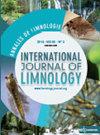Temporal variation in Oligochaeta species composition in an anthropized stretch of a Neotropical urban river
IF 0.9
4区 环境科学与生态学
Q4 LIMNOLOGY
Annales De Limnologie-international Journal of Limnology
Pub Date : 2022-01-01
DOI:10.1051/limn/2022006
引用次数: 4
Abstract
Aquatic environments in urban centers suffer constantly from changes in limnological variables, mainly due to increased pollution in these systems. Aquatic Oligochaeta are bioindicators of environmental change. The Iguaçu River is the second most polluted river in Brazil and in the Middle Iguaçu region is used for the public water supply. Efforts to understand the dynamics and conservation of this river are necessary, since this region has a gap in studies with aquatic invertebrates. Thus, the aim of this study was to investigate temporally the Oligochaeta species composition and the beta diversity of an anthropized stretch of a subtropical urban river, predicting that changes in abiotic variables cause changes in species composition and decrease the beta diversity over the years. We measured abiotic variables (water temperature, dissolved oxygen, electrical conductivity, pH, organic matter, aluminum and lead) and collected sediment samples using a grab in a stretch of the Iguaçu River over three years. We recorded 35 species of Oligochaeta and observed that changes in abiotic variables caused changes in species composition and beta diversity over the years, corroborating our prediction. The abiotic variables electrical conductivity, organic matter and aluminum were negatively related to species composition. In conclusion, the stretch studied in the middle Iguaçu showed an evident inter-annual variation in the Oligochaeta species composition, with a tendency to decrease the beta diversity, probably caused by changes in the abiotic variables.新热带城市河流人源化河段中寡毛纲物种组成的时间变化
城市中心的水生环境不断受到湖泊变量变化的影响,主要是由于这些系统中的污染增加。水生寡毛藻是环境变化的生物指标。伊瓜帕拉苏河是巴西污染第二大的河流,在伊瓜帕拉苏河中部地区被用于公共供水。努力了解这条河的动态和保护是必要的,因为该地区在水生无脊椎动物的研究方面存在空白。因此,本研究的目的是通过对亚热带城市河流一段人类活动河段寡毛纲物种组成和β多样性的时间调查,预测非生物变量的变化会导致物种组成的变化和β多样性的减少。我们测量了非生物变量(水温、溶解氧、电导率、pH值、有机物、铝和铅),并在伊瓜帕拉苏河的一段时间里用抓取器收集了沉积物样本。我们记录了35种寡毛藻,并观察到多年来非生物变量的变化导致物种组成和β多样性的变化,证实了我们的预测。非生物变量电导率、有机质和铝与物种组成呈负相关。综上所述,在伊瓜帕拉苏中部研究区,寡毛纲物种组成年际变化明显,有减少β多样性的趋势,这可能是由非生物变量的变化引起的。
本文章由计算机程序翻译,如有差异,请以英文原文为准。
求助全文
约1分钟内获得全文
求助全文
来源期刊
CiteScore
2.20
自引率
0.00%
发文量
0
审稿时长
>12 weeks
期刊介绍:
Annales de Limnologie - International Journal of Limnology publishes papers on the ecology of freshwater systems, ranging from studies of aquatic organisms, physical and chemical works which relate to the biological environment, to ecological applications and frameworks for water management directives.
Main topics: Ecology of freshwater systems ; biodiversity, taxonomy, distribution patterns in space and time, biology of animals and plants ; experimental and conceptual studies which integrate laboratory and/or field work on physiology, population dynamics, biogeochemistry and nutrient dynamics, management, mathematical modelling ; techniques for sampling and chemical analyses, ecological applications, procedures which provide frameworks for environmental legislation.

 求助内容:
求助内容: 应助结果提醒方式:
应助结果提醒方式:


